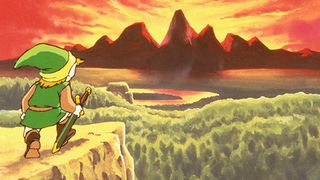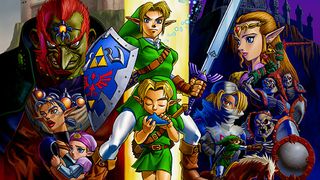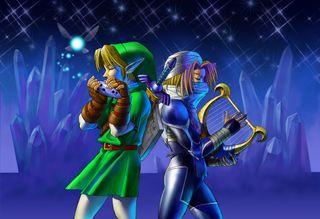Zelda 35th Anniversary: Why Zelda is Nintendo’s Star Wars
The Legend of Zelda has a mythic structure that's almost as old as humanity itself

This past week, The Legend of Zelda celebrated its 35th anniversary. Any series that lasts that long must have something special going for it. Why has the Zelda series captured our imaginations and never let go, when so many other early NES franchises have disappeared into the mists of gaming history?
Part of the answer lies in the games themselves. Ever since the very first installment, Zelda games have combined satisfying combat with clever puzzles, and explorable overworlds with devious dungeons. Zelda games often have memorable music and gorgeous graphics. And yet, you could say the same thing about plenty of other series, from Dragon Age to God of War. What makes Zelda, specifically, feel like a timeless cultural institution?
After thinking it over, I’ve come to the conclusion that “cultural” is the operative word in that sentence. Zelda feels distinctly different from other video game stories because it’s not structured like a video game story. It’s structured like a story that humans have been telling ourselves over and over since the dawn of our species: the monomyth. And if “monomyth” doesn’t sound familiar, don’t worry: You’ve heard it, too, probably more times than you realize.

What is the monomyth?
To compress an entire academic field into a few sentences: The monomyth, also called the Hero’s Journey, was codified by literary theorist Joseph Campbell back in 1949. His seminal book, “The Hero With a Thousand Faces” (Pantheon Books, 1949) argued that human cultures tend to tell the same story over and over again, particularly in dealing with mythic figures.
According to Campbell, this is the basic story structure for the monomyth:
“A hero ventures forth from the world of common day into a region of supernatural wonder: fabulous forces are there encountered and a decisive victory is won: the hero comes back from this mysterious adventure with the power to bestow boons on his fellow man.”
Phrased like that, it sounds pretty simple. And yet, this is arguably one of the most powerful tools in literary analysis. This is not only the story of Gilgamesh and Odysseus; it’s also the story of Rama, Yamato Takeru, King Arthur, Beowulf, Moses and Jesus. It’s the story of Bilbo Baggins and Luke Skywalker. And, yes, it’s the story of Link, too.
Sign up to get the BEST of Tom’s Guide direct to your inbox.
Upgrade your life with a daily dose of the biggest tech news, lifestyle hacks and our curated analysis. Be the first to know about cutting-edge gadgets and the hottest deals.
Campbell outlines 17 steps in the Hero’s Journey, divided into three main phases. In the Departure, the hero crosses the threshold between the mundane world and the magical world. In the Initiation, the hero faces many trials as he learns to navigate his new surroundings. Finally, in the Return, the hero confronts a final ordeal, and returns to the mundane world with new knowledge to share.
It sounds broad, but the individual steps are surprisingly specific — and just about every “epic” story really does follow them, from The Wizard of Oz, to The Lord of the Rings, to Dune. (George Lucas actually hewed so closely to the Hero’s Journey in creating Star Wars, that he invited Campbell to watch the movies with him. Not only did Campbell accept, but he loved the films!)
There’s much, much more to say about the Hero’s Journey — especially its “character archetypes,” which were inspired by Carl Jung’s psychological research — but for the moment, I’ll just assert that the most memorable Zelda narratives fit neatly into the monomythic structure. This is why Zelda “feels” different from most video games — and, perhaps, why we’re still clamoring for more, 35 years later.

Link and the Hero’s Journey
With almost 20 mainline Legend of Zelda titles to choose from, it’d be difficult to list every single instance in which Link’s adventures mirrored Campbell’s structure. To simplify, then, let’s examine The Legend of Zelda: Ocarina of Time. This N64 game from 1998 is arguably the most influential game in the series, creating a template for 3D action/adventure games that’s still in use today. It also fits Campbell’s structure almost to a T.
- Call to Adventure: Navi the fairy appears, urging Link to visit the Great Deku tree.
- Refusal of the Call: At first, Link refuses to wake up for Navi.
- Supernatural Aid: The Great Deku Tree grants Link Kokiri’s Emerald.
- Crossing the First Threshold: Link leaves the enchanted Kokiri Forest.
- Belly of the Whale: Link crosses a dark, narrow bridge between Kokiri Forest and Hyrule Field.
- The Road of Trials: Link gathers the Spiritual Stones, meeting friends and besting foes along the way.
- Meeting with the Goddess: Princess Zelda gives Link the Ocarina of Time.
- Woman as the Temptress: Link discovers that he can reverse time by giving up the Master Sword.
- Atonement with the Father/Abyss: Ganon taunts Link in the Forest Temple.
- Apotheosis: Link conquers Hyrule’s dungeons and gathers all six Sage Medallions.
- Ultimate Boon: Zelda bestows the Light Arrows upon Link.
- Refusal of the Return: Link (apparently) fears to lose Navi and Zelda after Ganon’s defeat.
- Magic Flight: Link and Zelda escape from Ganon’s crumbling castle.
- Rescue from Without: The six Sages bind Ganon and end Link’s battle.
- Crossing of the Return Threshold: Zelda uses the Ocarina of Time to return Link to the past.
- Master of Two Worlds: This time, Link fully understands his lineage, Zelda’s powers and Ganondorf’s treachery.
- Freedom to Live: Link and Zelda can thwart Ganon’s plans in advance; Hyrule remains peaceful.
There are other ways to interpret many of these steps, of course. Link is literally in the belly of a whale when he braves Lord Jabu-Jabu’s stomach. Link physically returns across a threshold when he arrives at Kokiri Forest in the end.
Furthermore, some of the steps don’t fit neatly in a game with a silent protagonist. Link never meaningfully refuses the call to adventure, and no woman (metaphorical or otherwise) ever tempts him away from it. Link has no “father figure” to speak of, and little meaningful interaction with Ganon before the final level.
Still, the point is not that every Zelda story checks every box of the monomyth. The point is that the monomyth is a perfectly viable framework for not just one Zelda adventure, but almost 20 of them. Link is called to adventure when his uncle bestows a sword on him; Link is called to adventure when his grandmother gives him the Hero’s Tunic; Link is called to adventure when he awakens from stasis and sees a broken Hyrule stretched out before him. There’s always a moment of Apotheosis when he gathers the doodads; there’s always an Ultimate Boon when he gets the item that beats the final boss; there’s always Freedom to Live after Link bests Ganon and sets things right.

A timeless myth
None of this is to say that The Legend of Zelda is a flawless series or that the monomyth is the only viable way to tell a story. Rather, the monomyth is a lens through which we can understand some of humanity’s most primal storytelling instincts, and the Zelda series is a perfect example. From the epic poems of antiquity to the most complex computer games, humans love a good yarn about a reluctant hero who sets out for adventure, acquires supernatural powers, conquers trials and returns home a changed man. This has happened to Link almost 20 times — and I’d wager that most fans are ready to see it happen 20 more.
There’s a long-running debate about whether video games count as art, and to comment on it would be above my pay grade. But the Zelda games are a strong argument that video games can count as myth — and if that’s true, then the “Legend” in the title is well-earned.
Marshall Honorof is a senior editor for Tom's Guide, overseeing the site's coverage of gaming hardware and software. He comes from a science writing background, having studied paleomammalogy, biological anthropology, and the history of science and technology. After hours, you can find him practicing taekwondo or doing deep dives on classic sci-fi.

